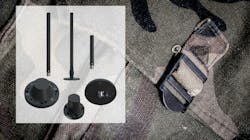Wideband Antennas Meet Military Requirements
Antennas are vital, if often overlooked, components within many high-frequency military systems. They are often subjected to rough treatment during in-field use and must perform reliably even with tough handling. To meet demands within many standard frequency bands, Pasternack, an Infinite Electronics brand, has introduced rugged antennas for Global Positioning System (GPS), L-band, C-band, and S-band applications (see figure). The antennas provide high gain and high power-handling capabilities for vehicles and portable manpack radios.
As an example of a GPS antenna, model PEANGPS1017 is a dual-band (L1/L2) model built to MIL-STD-810 specifications for manned and unmanned vehicles. It features 30-dB out-of-band rejection with 20-dBi gain and 3-dB noise figure. For L-band manpack radios, model PEANOM1140 is an omnidirectional antenna with N-type male connector and IP65 rating that delivers 3.5-dBi typical gain from 1.15 to 1.40 GHz. “With their ruggedness, reliability and exceptional performance, these antennas demonstrate Pasternack’s commitment to delivering cutting-edge solutions for our military customers,” said Product Line Manager Kevin Hietpas.
About the Author
Jack Browne
Technical Contributor
Jack Browne, Technical Contributor, has worked in technical publishing for over 30 years. He managed the content and production of three technical journals while at the American Institute of Physics, including Medical Physics and the Journal of Vacuum Science & Technology. He has been a Publisher and Editor for Penton Media, started the firm’s Wireless Symposium & Exhibition trade show in 1993, and currently serves as Technical Contributor for that company's Microwaves & RF magazine. Browne, who holds a BS in Mathematics from City College of New York and BA degrees in English and Philosophy from Fordham University, is a member of the IEEE.
